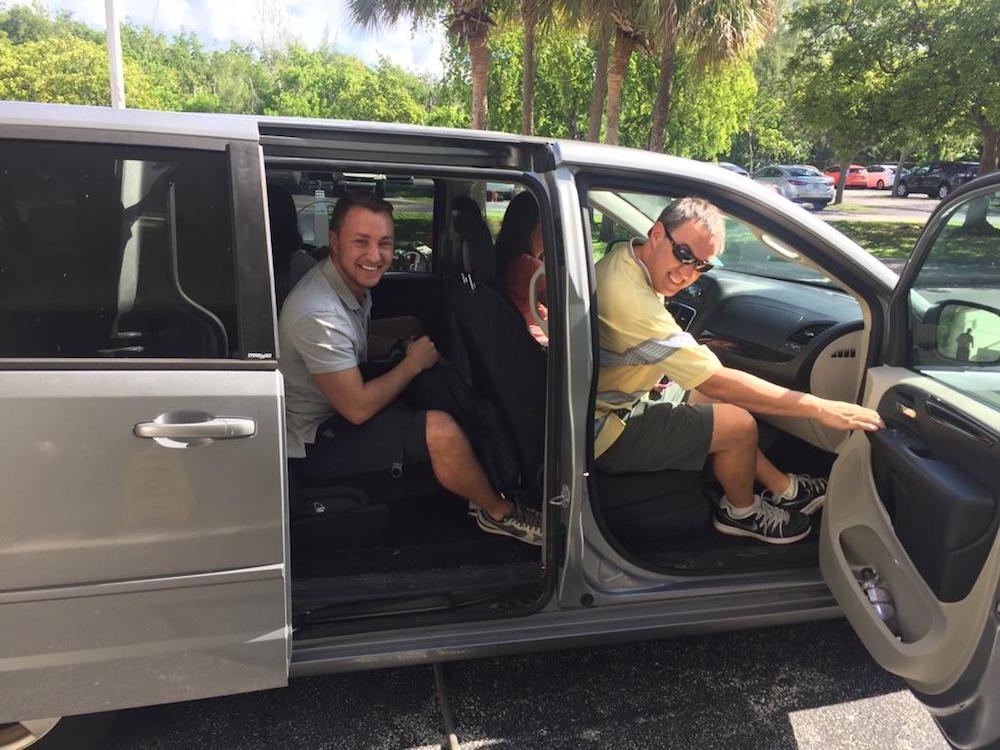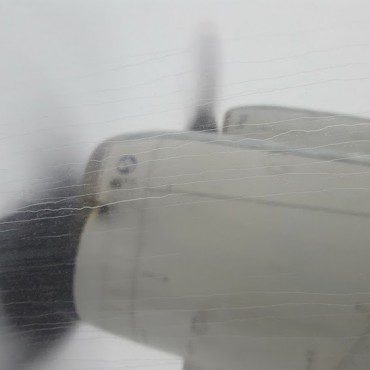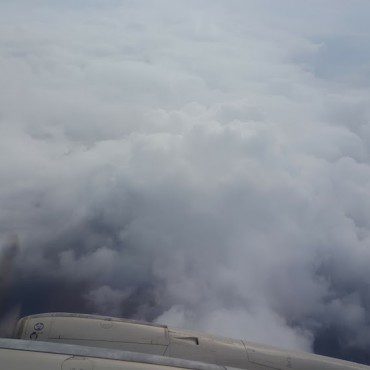By: Nicholas Komisarjevsky, Science Communications Intern NOAA AOML
There aren’t many people who can say they have flown directly into a hurricane, but on October 5, 2016, I had a very unique opportunity to fly into Hurricane Matthew with NOAA’s Hurricane Hunters. Matthew was quickly moving across the Atlantic Ocean, and each new forecast moved it closer to the East Coast of Florida. With the high potential for hurricane watches and warnings, NOAA started preparations for routine flight operations.
I was informed on Friday, September 30 they had a seat for me on a flight and four days later I was on my way to NOAA’s Aircraft Operations Center (AOC) at MacDill Air Force Base in Tampa, Florida. Along with the Hurricane Research crew from the Atlantic Oceanographic and Meteorological Laboratory (AOML), we settled in and got ourselves ready for the next morning. Takeoff was at 2:00 am.
Leading up to the flight I could feel a sense of unease, I wasn’t sure whether to feel nervous or excited. On the one hand flying into a hurricane sounds very dangerous, especially one as powerful as Matthew, but I kept reminding myself that the crew piloting the aircraft was trained and fully prepared so I became excited at the thought of flying. Nadine Schittko, a visiting AOML intern from Germany was very excited for the opportunity. “Since 2007, when I was 13 years old, I’ve wanted to fly into a hurricane. I was really excited, I was getting the opportunity to fly on a P-3 aircraft into Hurricane Matthew” she said. Nadine was able to take advantage of this unique opportunity through NOAA’s dedication to providing opportunities and grooming the next generation of scientists.
We arrived at the Air Force base a couple hours before our scheduled flight. We would be a crew of 20 with some of us penetrating a hurricane eye for the first time. Paul Hoffman, an Aviation Medical Officer (AMO) at AOC, reflected on how he felt leading up to this first hurricane flight, “Emotionally, I was excited and thankful to finally have the opportunity to participate in a hurricane flight. Professionally, very few medical officers have ever flown through the eye of a hurricane as part of their medical practice, so that was very rewarding to be able to take advantage of that opportunity.”
Before getting on the plane, I reported to a conference room to complete the required release paperwork and prepare for the mission briefing. We were tasked by NOAA’s Environmental Modeling Center to collect Tail Doppler Radar data describing Matthew’s core structure that would be used in the Hurricane Weather Research and Forecasting model (HWRF). This data, unique to the NOAA P-3 aircraft, provided detailed measurements of Matthew’s structure for HWRF to help better forecast intensity.
After the briefing, we walked out to the P-3 aircraft and I immediately noticed in the dark of the night it was the only aircraft on the runway. This evoked an odd sense of reality. I kept thinking to myself “we’re really going to do this, we’re really going to fly into a hurricane”. Once on board the aircraft, the first thing I noticed was the technology. There were computers on board for nearly everybody and they all had a purpose. Everybody on the aircraft had a defined role, and mine was to cover social media for the flight; to share with our Twitter followers the insights we were learning about Matthew by taking pictures, videos, and speaking with the crew (twitter.com/NOAA_AOML).
As everybody settled into their seat and the fasten seatbelt sign turned on, we geared up for takeoff. It happened almost in the blink of an eye; one second we were on the ground, safe and sound, the next we were on our way into Hurricane Matthew, a category 3 hurricane. Matthew was a very well-formed hurricane, and like most mature hurricanes it had a ring of clouds, the eyewall, that completely surrounded the clear eye in the center. The most turbulent part of most flights is when the aircraft penetrates the eyewall into the eye, and our flight was no different.
When we started our first penetration, there was a very significant change in tone as we hit the eyewall. The aircraft started to bounce from turbulence, but it was still dark so we couldn’t see anything outside the windows. Even though we were unable to see, there was no doubt in my mind that we were inside a hurricane. The highlight of the flight came about 4 hours later, when the sun started to rise and we were making another pass through the eyewall and into the eye. Looking out the window we saw thick fogs of gray, streaks of rain, and the turbulence in the aircraft started to pick up. Before we took off, all the newcomers had to go through safety training on the aircraft. This involved going over nearly every situation we might encounter, and how to best prepare yourself if that time should come. The NOAA Corps crew is thoroughly prepared for any situation, and they take safety very seriously.
We started bouncing up and down at a much faster rate, much like a very intense wooden roller coaster, as I tried to contain my stomach from getting too upset. As we pounded through the eyewall and made it into the eye, what I saw and experienced was truly breathtaking; thick white clouds above and below as far as the eye could see as blue skies and ocean attempted to pierce through, the turbulence experienced just moments prior was quickly winding down, and a sense of calmness surrounded us as we entered the eye of Hurricane Matthew. I was so taken aback by the magnitude of what I was seeing that I almost forgot to do my job and immediately started taking pictures and videos of the eye.
Nicholas Underwood, an Aerospace Engineer at AOC on his first hurricane eye penetration flight, said “The most exciting parts were the eyewall penetrations. I was told that it could get bumpy, but it was beyond anything I had imagined. Being in the eye itself was also incredible, that’s not a sight that many people get to see.” A couple penetrations later we were returning to Tampa. On our way back, I noticed myself coming in and out of sleep. The adrenaline rush experienced through the first few hours of the flight was over and the lack of sleep was catching up. We got off the plane, ate some breakfast, then got ready to do it all over again the next day. Coming out of the flight I gained a new appreciation for the crew that does this regularly. Every crew member that morning truly was professional, prepared, and made me feel safe in a situation that would otherwise be very fearful. My hat goes off to NOAA’s Hurricane Hunters, they truly excel at one of the toughest jobs in the world.
Originally Published October 2016 by Nicholas Komisarjevsky


